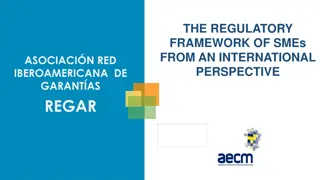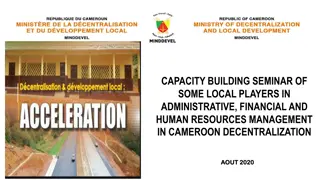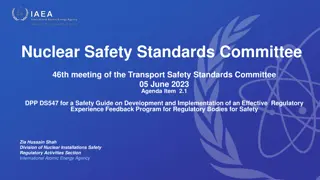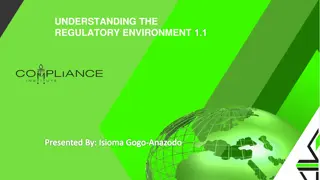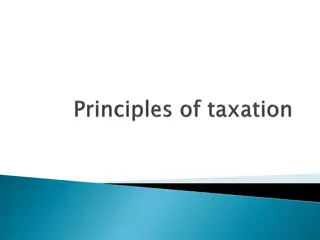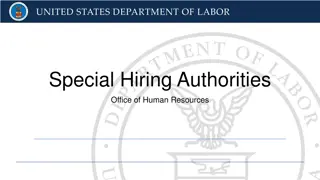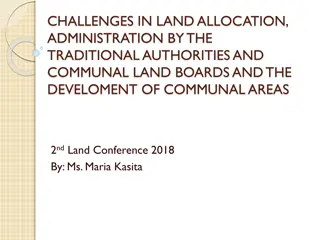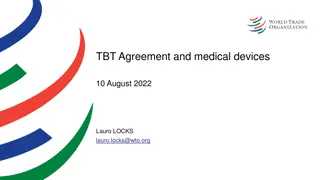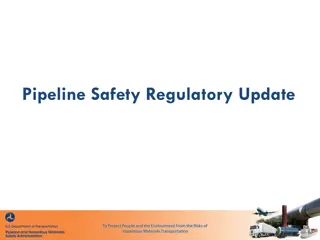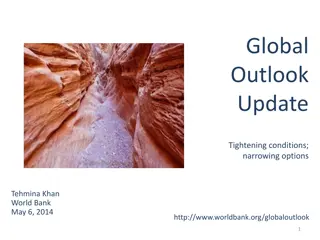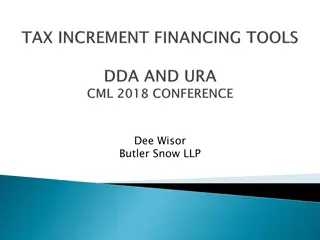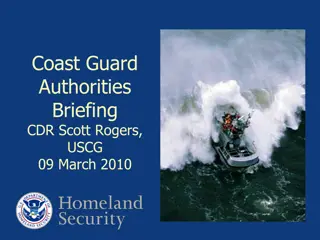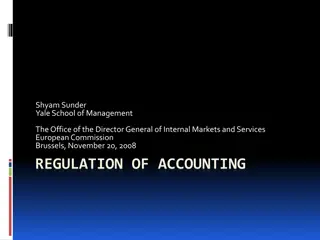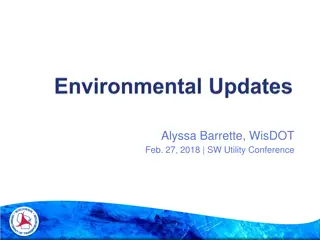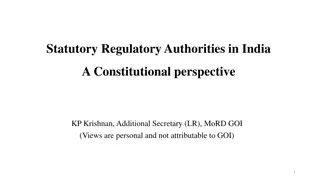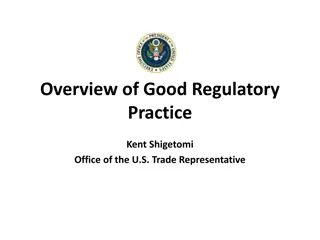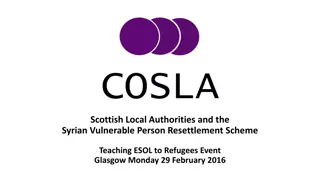
Understanding International Drug Regulatory Affairs and Regulatory Structures
Explore the world of international drug regulatory affairs, including the regulatory structures, the need for drug laws, regulatory scenarios in different markets, key regulatory agencies, common obstacles faced, drug registration procedures, and the drug approval process. Stay informed about the various stages and importance of conducting clinical trials in the pharmaceutical industry.
Uploaded on | 1 Views
Download Presentation

Please find below an Image/Link to download the presentation.
The content on the website is provided AS IS for your information and personal use only. It may not be sold, licensed, or shared on other websites without obtaining consent from the author. If you encounter any issues during the download, it is possible that the publisher has removed the file from their server.
You are allowed to download the files provided on this website for personal or commercial use, subject to the condition that they are used lawfully. All files are the property of their respective owners.
The content on the website is provided AS IS for your information and personal use only. It may not be sold, licensed, or shared on other websites without obtaining consent from the author.
E N D
Presentation Transcript
1 International Drug Regulatory Affairs
2 Regulatory structure The pharmaceutical industry is one of the highly regulated industries with various structures of drug regulation Druglaws Drug regulatoryagencies Drug evaluationboards Quality control laboratories Drug information centers
3 What is the need? Drug laws provide the basis for drug regulation Regulatory tools such guidelines equip authorities with the practical means of implementing those laws Regulatory Agencies implementation of these laws as standards and monitor the
4 Regulatory Scenario Regulated Markets Emerging Markets Latin America US Eastern Europe Canada CIS EU-27 states Africa Japan Asia Pacific Australia Gulf countries New Zealand
5 Regulatory Agencies USA Food & Drug Administration (FDA) The European Agency for the Evaluation of Medicinal Products (EMEA) Ministry of Health, Labour & Welfare(MHLW) Therapeutic Goods Administration (TGA) National Health Surveillance Agency (ANVISA) National Agency for Food and Drug Administration and Control (NAFDAC) State Food and Drug Administration (SFDA) Central Drugs Standard Control Organization (CDSCO) Uganda National Council for Science and Technology (UNCST) International Conference on Harmonization (ICH) World Health Organization (WHO) Europe Japan Australia Brazil Nigeria China India Uganda International
9 Obstacles Pharmaceutical, Non-clinical and Clinical issues emerge in all stages of development Regulatory guidelines don t always address problems encountered Language barrier Bureaucracy Political environment
10 Registration Procedure of Drugs for International Marketing
11 Drug Approval Process A regulatory process by which a person/organization/sponsor/innovator gets authorization to launch a drug in the market
12 Various Stages Application to conduct clinical trials Conducting clinical trials Application to marketing authorization of drug Post-marketing studies
14 API Plant Inspection Vendor Selection ApprovedAPI Excipients Packing Material Test, Import & Manufacturing License Patent/ development Strategy BE studies approved CRO Finished Product Development BE Strategy Dossier Writing Regulatory Filing to Authorities Dossier Evaluation Plant inspection Product Approval
16 Common Technical Document (CTD) Consists of documents like Application form, legal documents (GMP, Licences etc.), labelling etc. Required for generics and NewDrug Required for generics and New Drug. For generics summary on Quality part only required Summarizes Module 3, 4 and5 Provides abstract of documents provided in the wholeapplication Required forgenerics and New Drug Documents relatedto Chemistry, manufacturing and Control of both Drug Substance and Drug Product Critical assessmentof the clinical data and relatedreports Generics requireonly BE study Data on pharmacologic, pharmacokinetic, and toxicological evaluation of the pharmaceutical product Not required forgenerics
17 ICH Stability Zones Zone Zone I Zone II Zone III Zone IV Zone IVb Type of Climate Temperate zone Mediterranean/subtropical zone Hot dry zone Hot humid/tropical zone ASEAN testing conditions hot/higherhumidity Long Term Testing Conditions Climatic Zone Zone I Zone II Zone III Zone IV Zone IVb Refrigerated Frozen Temperature 21 C 2 C 25 C 2 C 30 C 2 C 30 C 2 C 30 C 2 C 5 C 3 C -15 C 5 C Humidity Minimum Duration 12 Months 12 Months 12 Months 12 Months 12 Months 12 Months 12 Months 45% rH 5% rH 60% rH 5% rH 35% rH 5% rH 65% rH 5% rH 75% rH 5% rH No Humidity No Humidity Accelerated and Intermediate Testing Conditions Climatic Zone Accelerated Ambient Accelerated Refrigerated Accelerated Frozen Intermediate Temperature 40 C 2 C 25 C 2 C 5 C 3 C 30 C 2 C Humidity Minimum Duration 6 Months 6 Months 6 Months 6 Months 75% rH 5% rH 60% rH 5% rH No Humidity 65% rH 5% rH
18 COUNTRY SPECIFIC GUIDELINES
19 Regulatory Agency Food & Drug Administration in this system Main consumer watchdog Center for (CDER) is FDA's Research and Drug Evaluation
20 Laws, Regulations, Policies & Procedures The Federal Food, Drug, and Cosmetic Act (1938) With numerous amendments it is the most extensive law of its kind in the world Code Of Federal Regulations (CFR) Section 21 of the CFR contains most regulations pertaining to food and drugs Manual of Policies and Procedures (MaPPs) Approved instructions for internal practices and procedures followed by CDER staff to help standardize the new drug review process and other activities
21 Types of Applications under Sec 505 New Drug Application (NDA) Abbreviated New Drug Application (ANDA)
22 New Drug Application (NDA) 505 (b) (1) 505 (b) (2) MA for changes to an approved drug (Change in dosage form, strength, indication etc.) MA for New Chemical Entities(NCE)
23 NDA Since 1938, every new drug has been the subject of an approved NDA before commercialization. The NDA application is the vehicle through which drug sponsors formally propose that the FDA approve a new pharmaceutical for sale and marketing in the U.S. The data gathered during the animal studies and human clinical trials of an Investigational New Drug (IND) become part of the NDA. Generally approval of an NDA is granted within two years (on an average), however, this process can be completed from two months to several years.
24 Applicable Regulations, Policies & Procedures (NDA) 21CFR Part 314 - Applications for FDA Approval to Market a New Drug or an Antibiotic Drug. MaPPs 5015-6:Review of the Same Supplemental Change to More than One NDA or ANDA in More Than One Review Division 6010.5:NDAs: Filing Review Issues 6020.8: Action Packages for NDAs and Efficacy Supplements 6050.1: Refusal to Accept Application for Filing From Applicants in Arrears 7211.1: Drug Application Approval 501(b) Policy 7600.6: Requesting and Accepting Non-Archivable Electronic Records for New Drug Applications.
25 Abbreviated New Drug Application (ANDA) Paragraph I For the products for which no patent information is availablein the orange book Paragraph II Used for the products for which all the applicable patents areexpired 505 (j) MA of generics Paragraph III Used for the patent products where the applicant confirms that the product will not be placed in the market till such patents are expired Paragraph IV Used for patentedproducts where applicant files the product which does not infringe thepatent. Successful applicantenjoys 6monthexclusivity
26 ANDA Applications are termed "abbreviated" as preclinical and clinical data is not required Reviewers focus on bioequivalence data, chemistry and microbiology data, requests for plant inspection, and drug labelling information. A generic drug must be comparable to an innovator drug in dosage form, strength, route of administration, quality, performance characteristics and intendeduse Once approved, an applicant may manufacture and market the generic drug product to provide a safe, effective, low cost alternative to the American public
27 Applicable Regulations, Policies & Procedures (ANDA) 21CFR Part 314 : Applications for FDA Approval to Market a New Drug or an Antibiotic Drug Part 320 : Bioavailability and Requirements Part 310 : New Drugs MaPPs: Chapter 5200 - Generic Drugs Bioequivalence
28 Data requirements Site Registration Yes Plant GMP approval US FDA Audit of both API and FP manufacture Stability Zone Zone I & II 25 2 C; 60% 5% RH Stability Requirements One pilot scale or minimum 100,000 units whichever is higher No. of submission batches Stability guidelines reference ICH Stability data 3 months Against US reference listed drug (RLD) in any country by USFDA app CRO BE study for generics Major Holdup Patent non-infringement, FDA audit, competition Dossier format CTD Registration time 12-24 months
29 Drug Registration Process in US Pre NDA Meeting 9-12 months prior to NDA submission Filing of NDA to FDA Application sent to CDER NotOK Checking Application Inform Applicant OK Notify theapplicant about deficiency Sent to Reviewer Submission of amended application Within 180 days -ve Submit review report to CDER Review of amended application -ve Rejection of Application +ve +ve Issue Marketing Authorization
30 COUNTRY SPECIFIC GUIDELINES
31 Regulatory Agencies EMEA Committee for Human Medicinal Products (CHMP)
32 Types of Procedures Centralized Procedure Decentralised Procedure Mutual Recognition Procedure National Procedure
33 Centralized Procedure When used Used for biologic products or other products using high- technology procedures Products for HIV/AIDS, neurodegenerative disease, dysfunctions, and viral diseases Products for orphan conditions Other new active substances at the request of the applicant Pros One application applies to all countries in the EU. Relatively quick procedure. A positive outcome is very beneficial to the sponsor. Cons A negative outcome will affect access to the entire EU cancer, diabetes, or other auto-immune
34 Centralized Procedure Guidelines EMA notified -120 Days Pre-Application Rapporteur/ Co-rapporteur appointed 14 Days Validation Application - validation CHMPscientific assessment and opinion CHMP scientific assessment 210 Days CHMP opinion Unfavourable Favourable 120 Days ApplicantAppeal Possible appeal EuropeanCommission DraftCommission Decision +90- 110 Days Decision-making process Decisionapproving Community authorization StandingCommittee
35 Decentralised Procedure When used Used for products that fall outside the scope of the EMA centralized procedure. Pros Simultaneous authorization in numerous countries in the EU. May be more efficient than national authorization since a positive outcome results in numerous country approvals. Sponsor can select which countries to apply to; does not have to be all EU countries. Cons A negative decision on an application may affect numerous countries.
36 Decentralized ProcedureGuidelines Report sent to Applicant Objection No Objection Application filed to CMS & RMS chosen Validation of Application by CMS (14 days) RMS assesses the application (120 Days) Report sent to CMS & applicant Objection not solved Objection not solved Objection EMEA/CHMP assess application (60 days) Member state having objection refuse to grant MA Report to co- ordination working group (60 days) CMS assess application (90 Days) NoObjection Objectionsolved Objectionsolved Communicateto RMS, CMS & Applicant NationalMA Granted
37 Mutual Recognition Procedure When used Individual application to one country within the EU for products that fall outside the scope of the EMA centralized procedure. Pros Review by one country and other countries accept the decision. Only one application needs to be submitted. Cons Individual national approvals can add significant time to the process. A negative outcome can affect numerous countries
38 Procedure Guidelines Similar to the de-centralized procedure with some differences. MRP is applicable to medicinal products which have received a marketing authorization in any member state whereas the decentralized procedure is applicable to those products which were never approved in any member states of the European Union. The evaluation of application by RMS can be taken within 90 days instead of 120 days (in decentralized procedure). After the grant of marketing authorization, the product can be marketed, which may be called as Phase IV trials, wherein new uses or new populations, long-term effects etc. can be explored.
39 National Procedure When used Individual applications to each country within the EU. Used for products that fall outside the scope of the EMA centralized procedure. Pros If application rejected in one country, can still access other EU countries. Cons Separate applications required for each country. Unique requirements required. and formats may be
40 Procedure Guidelines This type of authorization is granted on country- by-country basis by the competent authorities, in each member state. Each country within the EU procedures for authorizing application for a new drug. A sponsor can consult the website of the regulatory agency in each country in which it is interested in obtaining marketing approval to obtain details of the approval process. has its own a marketing
41 Data requirements Plant GMP approval Audit by any member states of EU Stability Zone Zone I & II 25 2 C; 60% 5% RH Stability Requirements 2 pilot scale + 1 lab batch No. of submission batches Stability guidelines reference ICH Stability data 6months Against European Reference Product (ERP) in any country. Fed, Fast and Steady state required. Patent non-infringement, GMP audit, high cost of registration, maintenance of registration, Administrative procedures for each member states. BE study for generics Major Holdup Dossier format CTD As per the procedure (DCP, MRP) schedule, Usually 12-18 months Registration time
42 COUNTRY SPECIFIC GUIDELINES
43 Regulatory Agency MHLW Pharmaceutical (PMDA) NDA/ANDA Application Review of GCP/GMP on-site inspection P ceutical affairs (PAFSC) Consultation on ReviewData and Medical Devices Agency & food sanitization council
44 Data requirements Site Registration Yes Audit by PMDA of both FP and API sites Plant GMP approval Stability Zone Zone II 25 2 C; 60% 5% RH Stability Requirements 3 pilot scale No. of submission batches Stability guidelines reference ICH Stability data 12 months Against Japan reference drug in any country BE study for generics Stand alone development, Quality by Design in practice, translations, generic acceptance Major Holdup Dossier format CTD Registration time 18-24 months
45 Drug Registration Process in Japan New DrugApproval Application PMDA PAFSC Compliance Review Consultation ApprovalReview Experts Nomination GMP review Advice Evaluation Committees Inquiry Notice of Review Results P ceutical Affairs Section Response MHLW (Evaluation & Licensing Div, PFSB) Approval & entry in NHI Price List Minister of MHLW (Final Evaluation) PFSB: P ceutical and Food Safety Bureau
46 COUNTRY SPECIFIC GUIDELINES
47 Regulatory Agency The TGA regulates therapeutic goods through: Pre-market assessment Post-market monitoring and enforcement of standards Licensing of Australian manufacturers and verifying overseas manufacturers' standards as their Australian counterparts Australian Drug Evaluation Committee (ADEC) Gives advice for new medicines Drug Safety and Evaluation Branch (DSEB) NDA/ANDA Application compliance with the same
48 Guidelines An application is submitted to TGA to register the drug in Australian Register of Therapeutic Goods (ARTG) after the completion of clinical trials. The application consists of data to support the quality, safety and efficacy of the product for its intendeduse. The application is assessed (on an administrative level) to make sure for compliance with basic guidelines and further evaluated by different sections and advice can also be sought on key issues to take final decision. A company can make comments on the evaluation report, if necessary.
49 Drug Registration Process in Australia Preparation & submission of Application to DSEB of TGA -ve Sent back to Applicant Application reviewed by entry reviewteam Accepted Evaluation of Application Within 225days Applicant comments onthe report and submits supplementarydata Sent to Applicant Report sent to TGAdelegates Applicant has an opportunity to comment on delegates report Delegates seek advice ofADEC Delegates make final decision notingany recommendation fromADEC Approval ofDrug
50 COUNTRY SPECIFIC GUIDELINES
51 Regulatory Agency State Food and Drug Administration(SFDA) Provincial Drug Administration Authorities(PDAAs) Organize the works of the formal review of submitted materials Centre for Drug Evaluation (CDE) Evaluate the submitted information
52 Drug Approval Process After formal review, the PDAAs send the qualified applications to the SFDA for further review. The import drug registration application should be directly submitted to SFDA by the applicant. SFDA s Department of Drug Registration carefully reviews the completeness of the submitted materials, files the qualified applications and transmits all the materials of qualified applications to the directly attached to SFDA. CDE determine whether the safety and effectiveness information submitted for a new drug are adequate for manufacturing and marketing approval and send the report of review to SFDA. SFDA carefully considers the recommendations of CDE and makes a decision whether or not the drug registration application can be approved and issues the certificate of drug approval and drug approval number to the qualified applicant.
53 New Drug Registration Process of China Filing drug registration application to PDAA After formal review Application sent to SFDA for reviewing the completeness Within 30 workingdays Dossier transferred from SFDA to CDE for technical review If complete within120 days If not complete Notify applicant fordeficiency Dossier transferred from CDE to SFDA for administrativeapproval Within 4months Resubmission of amended application by applicant Within 30days Within 40days Technical review report ofamended application by CDE Regulatory approval granted +ve Opinion of CDE on technicalreview -ve Refusal to Proceed
54 COUNTRY SPECIFIC GUIDELINES

